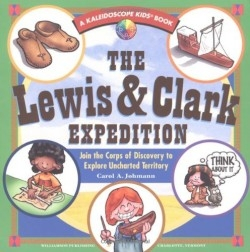The Lewis & Clark Expedition
Join the Corps of Discovery to Explore Uncharted Territory
“One pair of good mockinsons [sic] will not last more than about two days,” reported John Ordway, a member of the famous expedition. Needle seed grass, prickly pear cactus, and razor-like stones tore at the explorers’ footwear on portages.
Children aged eight through fourteen who are intrigued by history will enjoy this volume, which includes details usually left out of history books-the ones that make the explorers interesting-as the reader becomes part of the Corps of Discovery.
The journey, chronicled over ten chapters in journal form, begins in August, 1803. As the trip proceeds west from Pittsburgh, readers meet the members of the corps, learn about the provisions they needed and the problems they encountered, and discover the historical significance of the expedition. The author includes instructions for how to build a keelboat from balsa wood, make a Mandan earth lodge, carve a dugout canoe, and make moccasins. These projects are found throughout the book as the journey progresses to Oregon and back to St. Louis, two years later. Readers also learn to do a land survey to measure angles and distance, and to estimate distances using dead reckoning, as William Clark did to estimate the entire journey to the Pacific Ocean; by one account, he was accurate enough to be only forty miles off.
The book provides quotes from the actual journals of expedition members. On day one, May 14, 1804, Clark writes: “I determine to go as far as St. Charles, a French Village 7 leags up the Missourie, and wait at that place until Capt. Lewis could join me by land. …” When the travellers became hungry enough to eat their colts, a coyote, and finally candles, Lewis wrote, on day 492: “I feel myself growing weak for the want to food.”
“Think About It” questions invite readers to put themselves in the explorers’ shoes, and answer the questions they faced at the time. Resources and an index are included, as are stories of what happened to the travellers later in their lives. Illustrations are a mix of archival photos and pictures, realistic sketches, and cartoons in shades of dark sage and brown. Using historical documents, film, and other texts, the author, who has written about science for Time and Discovery, has created an award-winning series of hands-on children’s books about such topics as bridges, frontier settlements, and skyscrapers. This one will get kids excited about history.
Disclosure: This article is not an endorsement, but a review. The publisher of this book provided free copies of the book to have their book reviewed by a professional reviewer. No fee was paid by the publisher for this review. Foreword Reviews only recommends books that we love. Foreword Magazine, Inc. is disclosing this in accordance with the Federal Trade Commission’s 16 CFR, Part 255.

